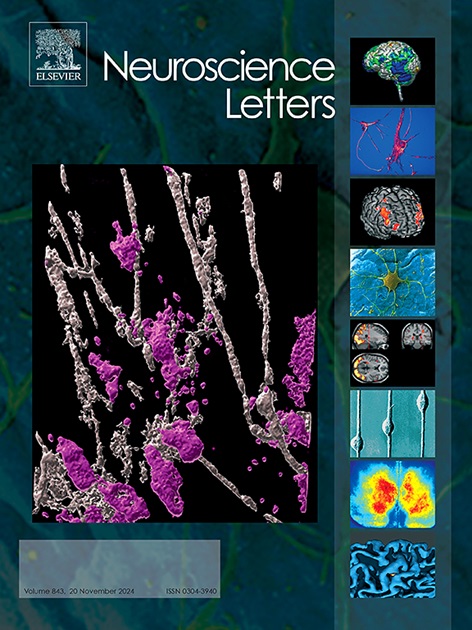研究金刚烷胺联合阿米替林在小鼠慢性不可预测轻度应激模型中的抗抑郁作用
IF 2.5
4区 医学
Q3 NEUROSCIENCES
引用次数: 0
摘要
金刚烷胺是一种n -甲基- d -天冬氨酸(NMDA)受体拮抗剂,传统上被用作抗病毒药物。在慢性不可预测轻度应激(CUMS)抑郁症动物模型中,研究了金刚烷胺与阿米替林(一种公认的三环抗抑郁药)联合使用时的潜在抗抑郁作用。本研究旨在评价该药物联合用药对缓解抑郁样症状的疗效。行为评估采用强迫游泳测试、悬尾测试、温度计测试和蔗糖偏好测试来衡量抑郁效果。进一步的生化分析显示,与对照组相比,CUMS组脑源性神经营养因子(BDNF)和去甲肾上腺素(NE)水平显著降低。BDNF对神经可塑性、突触调节和神经元存活至关重要,其水平降低与抑郁症的发展有关。同样,NE,一种参与情绪调节的关键神经递质,在抑郁状态下也经常减少。相反,CUMS组肿瘤坏死因子-α (TNF-α)水平显著升高,表明炎症反应增强,这也与抑郁症有关。金刚烷胺和阿米替林联合治疗产生了显著的抗抑郁样效果,行为参数的改善和该生物标志物的正常化证明了这一点,BDNF和NE水平的增加以及TNF-α的降低。本文章由计算机程序翻译,如有差异,请以英文原文为准。

Investigating the antidepressant effects of amantadine combined with amitriptyline in a chronic unpredictable mild stress model in mice
Amantadine, an N-Methyl-D-Aspartate (NMDA) receptor antagonist traditionally used as an antiviral drug, was investigated for its potential antidepressant effect in combination with amitriptyline, a well-established tricyclic antidepressant, in a Chronic Unpredictable Mild Stress (CUMS) animal model of depression. This study aimed to evaluate the efficacy of this drug combination in alleviating depression-like symptoms. Behavioral assessments were conducted using the Forced Swim Test, Tail Suspension Test, Actophotometer test, and Sucrose Preference Test to measure depressive effect. Further biochemical analyses revealed a marked reduction in Brain-derived neurotrophic factor (BDNF) and norepinephrine (NE) levels in the CUMS group compared with the control group. BDNF is crucial for neuroplasticity, synaptic regulation, and neuronal survival and its reduced level is linked to the development of depression. Similarly, NE, a key neurotransmitter involved in mood regulation, is often decreased in depressive states. Conversely, the CUMS group exhibited a significant increase in Tumour necrosis factor-alpha (TNF-α) levels, indicating enhanced inflammatory response, which is also associated with depression. Treatment with the combination of amantadine and amitriptyline resulted in a significant antidepressant-like effect, as demonstrated by improved behavioral parameters and normalization of this biomarker the increase in BDNF and NE levels along with a reduction in TNF-α.
求助全文
通过发布文献求助,成功后即可免费获取论文全文。
去求助
来源期刊

Neuroscience Letters
医学-神经科学
CiteScore
5.20
自引率
0.00%
发文量
408
审稿时长
50 days
期刊介绍:
Neuroscience Letters is devoted to the rapid publication of short, high-quality papers of interest to the broad community of neuroscientists. Only papers which will make a significant addition to the literature in the field will be published. Papers in all areas of neuroscience - molecular, cellular, developmental, systems, behavioral and cognitive, as well as computational - will be considered for publication. Submission of laboratory investigations that shed light on disease mechanisms is encouraged. Special Issues, edited by Guest Editors to cover new and rapidly-moving areas, will include invited mini-reviews. Occasional mini-reviews in especially timely areas will be considered for publication, without invitation, outside of Special Issues; these un-solicited mini-reviews can be submitted without invitation but must be of very high quality. Clinical studies will also be published if they provide new information about organization or actions of the nervous system, or provide new insights into the neurobiology of disease. NSL does not publish case reports.
 求助内容:
求助内容: 应助结果提醒方式:
应助结果提醒方式:


